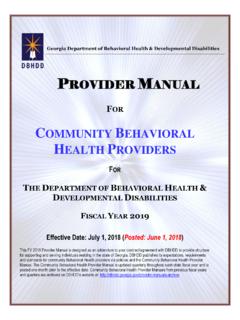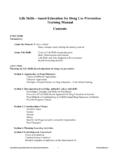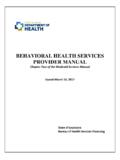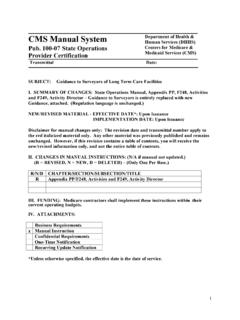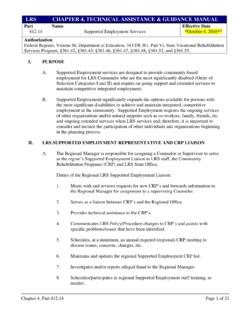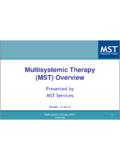Transcription of WORKING WITH GROUPS A GROUP FACILITATION …
1 National Center for training support , & Technical Assistance PROCEED INC. WORKING with GROUPS : A GROUP FACILITATION manual 2 WORKING with GROUPS : A GROUP FACILITATION manual Date: September 2009 PROCEED, Inc. wishes to acknowledge the authors of this guide, Drs. Raquel C. Andres Hyman and Chyrell D. Bellamy of Yale University s Program on Recovery and Community Health. We also thank the staff and personnel of PROCEED, Inc. s National Center for training , support , and Technical Assistance (NCTSTA) for their review and input throughout the curriculum development process. This publication was supported by the Cooperative Agreement # U65/CCU223697-05 FOA# 04019 from the Centers for Disease Control and Prevention (CDC). Its contents are solely the responsibility of the authors and do not necessarily represent the official views of the CDC. National Center for training , support , and Technical Assistance (NCTSTA) 1126 Dickinson Street Elizabeth, New Jersey 07201 3 About the National Center for training , support , and Technical Assistance (NCTSTA), at PROCEED, Inc.
2 PROCEED, Inc. s NCTSTA stands as a leader in the field of organizational infrastructure development and prevention interventions for agencies WORKING with minority populations at high risk for HIV, STDs, and substance abuse. PROCEED's mandate to implement a broad spectrum of federal and state programs reflects the reputation and confidence the organization has earned to deliver its services with excellence and a high level of consistency and cultural competency. PROCEED, Inc. s Mission Statement: To provide community based and human services organizations with the tools, knowledge, and skills necessary to enhance, maximize, and sustain their organizational infrastructure and intervention services. PROCEED, Inc. is committed to providing our constituent organizations with the resources and tools to support and strengthen their respective operational frameworks and enhance their HIV prevention interventions.
3 4 About the GROUP FACILITATION manual : The GROUP FACILITATION manual provides a foundation for WORKING with GROUPS , including: skills for facilitating GROUPS ; steps to planning GROUPS ; and, steps for evaluating GROUPS . These steps can be especially useful if you have little or no experience facilitating GROUPS , or can serve as a refresher or resource if you are currently conducting or planning to conduct GROUPS . The Diffusion of Effective Behavioral Interventions (DEBI) project lists several interventions that are either GROUP based or contain GROUP based components, such as: Healthy Relationships (HR) Holistic Health Recovery Program (HHRP) Many Men, Many Voices (3MV) Safety Counts Street Smart Together Learning Choices (TLC) Voices/VOCES If you plan to implement one of the evidenced based interventions, refer to the DEBI website for specific information on the implementation of the GROUP based intervention.
4 Included for the majority of these interventions are implementation logic models; agency assessment readiness checklists; fact sheets; and, procedural guidelines. Visit for further details. 5 manual Contents About the NCTSTA at PROCEED, Inc. Page 3 About the GROUP FACILITATION manual Page 4 manual Contents Pages 5 6 Chapter 1: Overview of GROUPS Pages 7 12 Defining GROUP Work Types of GROUPS Chapter 2: Planning for GROUPS Pages 13 29 Steps for Planning Step 1: Defining the GROUP s Purpose and Goals Step 2: Planning the GROUP A. Deciding on the structure of the GROUP B. Deciding GROUP Composition C. Deciding Location for the GROUP D. Choosing a time for GROUP meetings E. Preparing an organization for a GROUP F. Planning for Incentives Step 3: Getting people to the GROUP : Recruiting and Interviewing Members for the GROUP Chapter 3: Overview of GROUP FACILITATION Pages 30 52 Defining GROUP FACILITATION Facilitating Individual Change in GROUPS Skills for Facilitators Inventory of Skills Common Problems in GROUPS Co FACILITATION 6 Chapter 4: Conducting GROUPS Pages 53 68 Conducting GROUPS based on the GROUP Developmental Phases Chapter 5: Evaluating GROUPS Pages 69 74 Conclusion Page 75 Appendices 1.
5 Questions for Interviewing GROUP Members Pages 76 77 2. Sample GROUP Contract Page 78 3. Sample Participant Evaluation Form Page 79 4. Sample Facilitator s Process Form Page 80 5. Self Reflection Checklist for Facilitators Pages 81 83 Bibliography Page 84 7 Chapter One Overview of GROUPS Defining GROUP Work: GROUP work: Goal directed activity with small GROUPS of people aimed at meeting socioeconomic needs and accomplishing tasks (led by trained GROUP facilitators)1. The activity is directed to individual members of a GROUP and to the GROUP as a whole within a system of service delivery (modified from Toseland & Rivas, p. 12). In recent years, GROUP work has become a primary method of service delivery in psychosocial and behavioral health oriented programs. GROUPS are particularly useful in WORKING with people who have experienced a sense of isolation because of a defined issue or problem; allowing individuals to connect with others with similar experiences.
6 A well facilitated GROUP can serve as a simulation of relations in life outside of the GROUP with the intent that the GROUP will model real world relationships and help people transfer the skills they learn in the GROUP to their actual relational experiences with others outside the GROUP . GROUPS enable people to join forces in bringing about change in their service agency, in the community, and in the larger society. GROUP work in HIV prevention can provide the following for GROUP members: Members support each other in pursuing personal change goals; Members learn from each other s ways of coping and dealing with challenging situations; Members feel less isolated or stigmatized, and are able to express and discuss feelings People in the same boat often more quickly 1 Words in italics are not quoted in Toseland & Rivas s original definition.
7 8 understand one another than people who do not share common problems and experiences; Members learn new ways of being in relationships by developing healthy communication styles and learning often learning through opportunities in the GROUP to create simulations (role plays) of real life situations; and, Members have the opportunity to give back to be a helper and not the one always being helped. Types of GROUPS : There are several types of GROUPS . In general, GROUPS have been used for the following purposes: A. support Mutual Aid GROUPS B. Intervention Specific GROUPS C. Prevention Focused GROUPS D. Motivational GROUPS E. Social Change GROUPS F. Task oriented GROUPS (such as planning GROUPS , etc.) A. support Mutual Aid GROUPS provide a support system for individuals who have similar experiences and needs. These GROUPS can be thought of as modeling ways that individuals can help each other because others in the GROUP may have had similar experiences.
8 The GROUP dynamic helps to empower GROUP members, by giving them an opportunity to give back by helping others. Popular types of mutual aid GROUPS include self help programs such as Alcoholics Anonymous and other 12 step programs; or HIV support GROUPS . Mutual aid GROUPS are often identified as non structured or loosely structured because these GROUPS are based on what individuals want to talk about or deal with on any given day. Many self help oriented GROUPS are considered open ended GROUPS because members come 9 and go meaning there is no set number of sessions, or there is a rolling admission based on dropout rates, waiting lists, etc. Example: In HIV programs, these GROUPS are generally specific to identified populations, such as women s support GROUPS or support GROUPS for gay men. These GROUPS are sometimes facilitated by someone with a similar experience, who positively models ways of living with HIV.
9 B. Intervention Specific GROUPS usually are based on an established program manual /curriculum or GROUP model. Many of the evidence based practices have incorporated GROUP based components. These GROUPS are structured to incorporate various program activities to help individuals work toward change or development. It is important for GROUP facilitators to understand the various elements of the intervention model in order to adapt it to the needs of their GROUP . This requires time for facilitators to learn about the intervention before the GROUP begins. Facilitators should refer to for a review of nationally recognized prevention interventions endorsed by the Centers for Disease Control and Prevention (CDC). Example: The Safety Counts intervention is specifically designed for people who are using illicit drugs and who have not indicated readiness for change towards stopping their drug use.
10 The intervention is designed to assist individuals in understanding the relationship of their drug use to risk factors for HIV infection, and to assist them in developing a plan for risk reduction. Safety Counts uses individual and GROUP level methods to reach these goals. Two GROUP sessions are planned to identify individuals HIV risks and current stage of change. In these sessions, individuals learn from hearing successful risk reduction stories, set personal goals, and identify first steps to reducing HIV risk. In addition to the structured GROUP sessions, the intervention requires that two (or more) GROUP social events be planned for members to socialize and receive reinforcement for risk reduction. Planned HIV related risk reduction activities are integrated into 10 these social events, such as playing a game that reinforces HIV related skills learned in the sessions.


